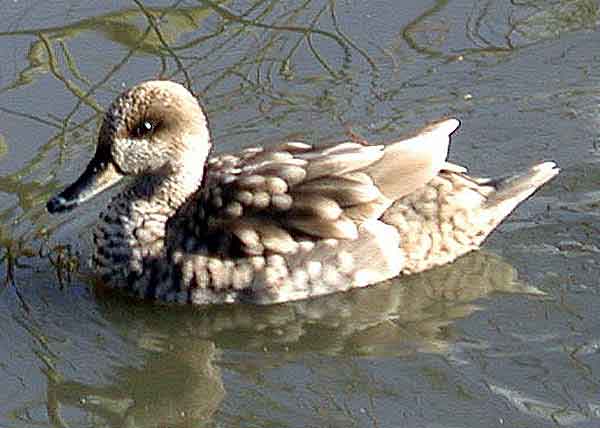Marmaronetta angustirostris (*) Cladus: Eukaryota Name Marmaronetta angustirostris (Menetries, 1832) Vernacular names The Marbled Duck, or Marbled Teal (Marmaronetta angustirostris), is a medium-sized duck. It used to be included among the dabbling ducks, but is now classed as a diving duck. This duck formerly bred in large numbers in the Mediterranean region, but is now restricted to a few sites in southern Spain and northwest Africa. In the east it survives in the Mesopotamian marshland in southern Iraq and in Iran (Shadegan Marshes - the world's most important site), as well as isolated pockets in Turkey, Armenia, Azerbaijan, Iraq and further to the east in western India and western China.[1] Its breeding habitat is lowland where they lay their eggs in long grass or in high trees. They may lay 7 to 10 cream eggs. They are common in private collections but are a nervous and flighty bird. In some areas birds disperse from the breeding grounds, and have been encountered in the winter period in the Sahel zone, south of the Sahara. The Marbled Duck is approximately 39–42 centimetres (15–17 in) long. Adults are a pale sandy-brown colour, diffusely blotched off-white, with a dark eye-patch and shaggy head. Juveniles are similar but with more off-white blotches. In flight, the wings look pale without a marked pattern, and no speculum on the secondaries.[2] These are gregarious birds, at times even when nesting. Outside the breeding season flocks are often small, although large wintering flocks have been reported in some areas. The largest winter concentration known is in Khuzestan, Iran.[2] In 2011, a group of Iraqi ornithologists counted a single flock of the rare marbled teal on the lakes of the Iraqi marshes, numbering at least 40,000 birds.[3]
This bird is considered vulnerable due to a reduction in population caused by habitat destruction and hunting. It is one of the species to which the Agreement on the Conservation of African-Eurasian Migratory Waterbirds (AEWA) applies.[1] The scientific name, Marmaronetta angustirostris, comes from the Greek marmaros, marbled and netta, a duck, and Latin angustus, narrow or small and rostris billed.[4] 1. ^ a b BirdLife International (2008). Marmaronetta angustirostris. In: IUCN 2008. IUCN Red List of Threatened Species. Downloaded on 14 November 2008. Database entry includes a range map and justification for why this species is vulnerable. Source: Wikipedia, Wikispecies: All text is available under the terms of the GNU Free Documentation License |
|

